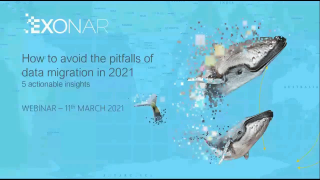Improve data quality and remove risk before a data migration
Understand what legacy data you have, where it is and how old it is. Reduce storage costs, increase scalability, and accelerate digital transformation by finding and fixing your data before you migrate.

Minimise costs, improve data quality and reduce risk
Storage cost reduction by removing high-risk information
Of risk reduction by removing sensitive information accurately
ROI from the precision to classify or separate critical data
"There’s a cost associated with moving our legacy data to the cloud. Exonar gives us the laser precision to discover the data we need and the peace of mind to delete with confidence. Over a 2-4 year period that equates to an ROI of 200%.”
CTO, Global Pharmaceuticals company
Related Content:



Report: The Ultimate Guide to Data Migration
Webinar: How to avoid the pitfalls of data migration in 2021
Three transformational steps to a successful data migration
Gain a complete view of all your data sources in one place
Drill into each item and use data visualisations to easily establish what is business critical and what can be removed before you migrate. Find the duplicated, redundant, obsolete and trivial information that can be archived or deleted, and the high risk or sensitive information that needs to be kept on-premise.
Find sensitive and legacy information hidden in your unstructured data
Identify risk quickly using pre-built search and use document previews and metadata summaries to quickly review the data in a file. Search for toxic and risky unstructured information such as encryption keys and highly sensitive data. Use the Similar Files feature to identify related or duplicated documents that need to be secured or removed prior to migration.
Identify the high risk areas in your data at scale
Use the pre-built but configurable dashboards and drill into the details of the content using the graphs to explore standard or enriched metadata, filtering by low, medium and high risk. Gain quick oversight of the documents and files that contain significant amounts of sensitive or critical information which need to be encrypted or kept on-premise prior to your migration.
Locate your most corporate sensitive information before migration
Establish which data stores are holding large volumes of PII and understand the sensitive subjects and topics most referred to in your organisation’s unstructured data. Identify risky or sensitive information stored in unexpected data stores that needs to be categorised or archived.
